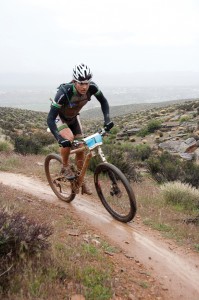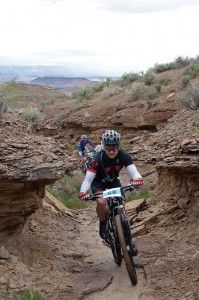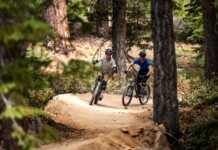
By Cimarron Chacon
Note: This article is on the 2011 edition. The 2012 edition is March 17, 2012. See gropromotions.com for info.
This is not your typical race article about winners and losers, and race statistics. Why, because at a point during this race it became a race for survival not a competition to get back first. It became a tale of heroism, perseverance, determination, fortitude against adversity, comradery between fellow mountain bikers, and every single person out on course displayed true grit.
At 5:00 am the forecast for the True Grit Epic Mountain Bike Race in St George, Utah on March 26, 2011 said 10% chance of rain and a high of 63. Ideal weather conditions for a long distance race in the southern Utah desert. Around 8:15 am racers began to line up at the start/finish line to get their spot and await the critical information during the racer meeting. There was a lot of excitement in the air and anticipation for the inaugural race on the new tough and technical course laid out in the rugged landscape just west of town. Many of the racers choose to dress as light as possible to avoid overheating on the long climbs. With almost 7000 feet of climbing over 50 miles and a roster of strong experienced athletes, those going for the podium knew there would not be time to shed layers once the race began.
At 8:50 one hundred and seventy racers, many whose first introduction to St George riding would be that day stood shivering under an increasingly cloudy sky, the sun barely visible behind the thick haze. The Open-male category and 35+ male category had filled to over 60 racers each, others were racing in the Single Speed or Masters categories and there were 14 racers lined up to attempt the Challenge course, a course that is half the distance of the full Epic but includes the toughest terrain.
The pre-ride meeting concentrated a lot on course information. The route was to begin on pavement through town for 1.8 miles before jumping onto the familiar roads and trails used by the Red Rock Rampage Intermountain Cup race, however racers familiar with that course would be confused if they did not pay attention as this new course quickly diverged with an additional up and down on the Red Bluff Mesa, with a climb, not a descent, on the final single track where they would keep on climbing until they reached the Barrel Ride Trail. The Barrel Ride would dish out 3 very steep and technical descents that only the most skilled technical riders would master – even walking them would not be easy – but then there would be ZEN. The Zen trail is St George’s version of Gooseberry, only with elevation. Just a mere 6 miles, this trail dishes out some tough and technical moves, both climbing and descending, in a very short distance. After completing Zen, the Challenge racers would split off for the finish line while the Epic racers would take on yet another steep climb to access the Bear-Claw Poppy and Stucki Springs trail systems as they headed out into the desert toward the City of Santa Clara. For many racers this long stretch, although technically much less demanding, would feel remote and present its own set of challenges. From Stucki Springs the Epic course would take the racers on a portion of the Rim Runner/Reaper trails and then a loop on Barrel Rolls, before heading back down a dry wash called Cove Wash to reach Green Valley and the finish via Dixie Drive back to the park.
At 9:00 sharp the race was off. The sight of 170 racers pouring out of Tonaquint Park was impressive and exciting. The front racers reached the first single track sections within 6 minutes of the start and spectators flocked to the top of Canyon View Dr., near the first aid station, where they could get a birds-eye view as mountain bikers traversed the trails on Red Bluff and over to Zen. There were 25 checkpoints on the trail, with a volunteer course marshal or trained medic stationed at each one. The first report came in from Check Point 6 at 8:48 am that Alex Grant, number 68, had already taken a strong lead as the race front runner. The first aid station began bustling around 9: 15 am as the front runners came through to get their check stamp before heading on the Zen loop. They were coming through fast and the race was getting very exciting.
At 9:40 it began to rain -just a little drizzle and spiting. Volunteers grabbed their jackets and hats and racers started pedaling just a little faster. But by 9:50 spotters further on the trail began reporting worsening conditions on the south side of Red Bluff. Because all racers were still on the Zen, officials and volunteers began scrambling to implement the rain contingency plan and avoid any trail damage to some of the more fragile trails. This course change is almost a one for one swap giving racers the same 52 miles they would get from the original course and almost the same amount of climbing as well. Every checkpoint person was instructed to tell each rider of the course change. This decision was made mainly in a response to permit requirements through the poppy habitat and for the sake of the singletrack trails – no one anticipated the rain would persist and even get stronger.

At 11:17:20 Jace Heger of St George finished the Challenge race well ahead of an anticipated finish. This was his first endurance race and he crushed the rest of the field by almost 20 minutes. When he arrived he was wet but warm and happy. The first female Challenge racer, Debbie Mortensen, arrived at 11:32:32, also with a solid lead in the female category by 23 minutes. The race for second place was close, however, with second place Lyna Saffell finishing ahead of third place DJ Morisette by just 01:37. As the rest of the field came in there were no obvious signs of trouble, but the phone calls from the other end of the course painted a very different picture.
Beginning around noon reports of worsening conditions began to come in rapidly: Reports of the Stucki Springs Jeep Road becoming slimy and difficult to ride and reports of people choosing to drop out of the race. Stories by racers paint a gruesome picture of broken bike parts and suffering. But they also paint a picture of caring and heroism. As the line between warmth and comfort and despair and hypothermic conditions became thinner, racers began to buddy up, often with people they had never met, to assure all reached safety. The course had been designed with bailout spots, and it was at this point (check point 20) that this design element became critical in saving lives. With Volunteer Danny Christensen leading the effort, he was able to redirect people at mile 27 to head directly to Hwy 91 in Santa Clara, only a mile away, instead of taking the 17 miles of designated course.
Reports continued, by 12:30 Cove wash began filling up with water and muck and racers who had made it past check point 20 were in serious shape with hypothermia at Aid Station B located at the Barrels Rolls trail head. Many of these folks had already completed one or two laps on the rolls, a loop that throws the technical climbing back into the race at mile 31. The first ambulance arrived at 12:40, along with volunteers to haul people out. Bryan Alders, Team Epic Endurance, of Boulder Colorado “rode in second place most of the day until the fierce cold forced him to trade is bike in for an in an ambulance ride.”
By 1:03, when Utah’s Alex Grant (Cannondale) rolled over the finish line in a record 4 hrs 3 minutes and 30 seconds he was clearly showing signs of hypothermia himself. At 1:32, when second place Open male finisher Chris Holley (Trek 29er Crew) also from Utah rolled over the finish the event was in the midst of a full force rescue effort. The focus became not on finishing order or place but on accounting for bodies. People were in desperate conditions and the fastest and closest way to safety was straight to the road. Conditions became so bad that many rescue vehicles could not reach the second aid station due to thick mud. It was feared that if necessitated, there would be no way to launch a rescue into Cove Wash or Green Valley. The last few racers through had reported bikes coming to a complete stand still from the thick clay mud and grit. If people continued to attempt this part of the route it was obvious that a rescue from a flowing wash with blue clay would be impossible. Finally, volunteers, many who had been standing in the elements for the entire day, were beginning to report hypothermic conditions in themselves. At 12:55 pm the race was called and Cove Wash and Barrel Rolls were shut down. Those still out on the Barrel Rolls were watched by volunteers carefully. All efforts were redirected to shuttle vehicles and only a bare bones crew was left at the finish line to check off numbers of those who had made it back.
In all, 44 people were hauled off the course, some in very bad shape. The rest took the road back to the park. This was still not an easy feat, traveling at higher speeds in the wind and cold. Most racers rode together in groups to keep an eye out for one another. Many reported numb hands and seeing spots as they neared the park entrance. There were a total of 8 Open Males and 1 Masters that received an officially timed finish before the race was called. However, the course was cleared within 2 hours of the closure and everyone made it to safety.
By 4:30 pm the sun was shining. Those who had warmed up returned for music and a feast of bbq pork, rice, beans and corn bread and to watch and cheer for those receiving awards. Some were undeterred and looked forward to the future, “I made up my mind to do this next year as I was shivering uncontrollably back at the start/finish area,” said Riley Frazer. Alison Vrem reflected on the day, “It was one of the most challenging things I have ever done.”
A report was created showing official finishing times as well as self–reported times of where racers were on course at the time of the shutdown. Because that day, everyone displayed true grit. See
www.gropromotions.com/results.html for details.







